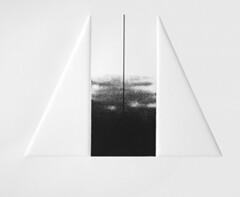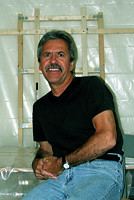Twenty Contemplations on the Infant Jesus: An Homage to Olivier Messiaen
Catalogue essay: the Art Institute of Chicago, January 22 to March 15, 1981
Twenty Contemplations on the Infant Jesus: An Homage to Olivier Messiean
I chose the French composer Olivier Messiaen’s piano composition, “Vingt regards sur l’Enfant Jesus (Twenty Contemplations on the Infant Jesus), as the theme for these prints so that I may pay homage to a man and to an art form that has been a great source of inspiration to me.
In “Vint regards,” Messiaen took up the same ideas of Dom Columbia Marmion (Le Christ dans ses mysteres) and Maurice Toesca (Les Douze regards) wherein they spoke of the contemplations of the shepards, of the angels, of the Virgin and of the Celestial Father. “Vint regards,” according to Messiaen, is an adaptation of these four themes while at the same time an addition of sixteen new contemplations. In speaking about the contemplations, Messaien has said that “…More than in all my preceding works, I have looked here for a language of mystical love, to be varied, powerful and tender, sometimes brutal, responding to multicolored commands.” I too, in these twenty intaglio prints, have tried to formulate such a language – a language befitting the sublime nature of the subject.
The first phase of this work began with a series of pencil drawings and then was extended into the medium of printing. It was in the process of creating theses images that an appreciation of the various intaglio techniques (etching, drypoint, electrically vibrated drypoint mezzo-tint, engraving, and aquatint) became a dominant factor in the series. This was especially true when I realized that if I ignored certain relationships inherent within the medium, the language I sought would be severely limited. Some of the formal elements, such as line, space, and texture, that were peculiar to intaglio, revealed new possibilities when combined with blind embossing (a depressed element printed without ink). Accepting this interchangeability as a challenge and an opportunity to explore, I found that my visual interpretations often changed dramatically from the earlier drawings. It was during this change and while attempting to synthesize idea and emotion with the process that I experienced the fine line which connects form and expression, when personal meaning and the medium function as one. It was a moment in which I was fully able to appreciate and experience a sense of the self, the medium and the unexpected.
I hope that with these twenty contemplations I have given to Olivier Messiaen the respect and the admiration that he so richly deserves, and that I have remained respectful of the medium of music which he loves. Perhaps Messiaen would agree that when J.S. Bach one of the canons in his “Musical Offering,” “Quaerendo invenietis” (By seeking, you will discover) that Bach should have added “the unexpected” as well!
Daniel P. Ramirez
September 25, 1980
Chicago, Illinois
Note* A suite of twenty intaglio prints, in an edition of ten, plus five artist’s proofs. The prints were pulled by the artist and Dennis McWilliams at the Chicago Center for the Print, between August and December 1980. The image size of each is noted in the catalogue; they were printed on Arches paper of approximately 565 x 760 mm. The prints in the exhibition are marked A.I.C.Proof and are the gift of Mr. And Mrs. Herman Ramirez.
The study drawings in graphite, on Strathmore paper of approximately 587 x 738 mm., are the gift of the family of Mrs. Dorothy Gomez-Schultz in her memory.
The trial proofs, on Rives or Arches paper, are also the gift of the family of Mrs. Gomez-Schultz.



2 Comments:
I had a chance to read your article, "Twenty Contemplations." I think the artistic search for a "language," as described in this piece is full of implications both for Wittgenstein and Heidegger. In particular, there is a highly unconventional feeling for representation by which Witt goes in search of his "grammar," a grammer which obviously has nothing whatever to do with The Little Brown Handbook. In other words, language in the more conventional text has acquired a structure of usage and the business of identifying the contours of this usage is rather like the navigation by intuition, as I envision it, that enters into artistic creation (e.g., formulating "a language befitting the sublime nature of the subject." This is a kind of innovation to which, I must say, I have never given much thought. However, while the lines do diverge, they also come together again, for the philosopher would be poor indeed to could not relate to your concluding observation, "It was a moment in which I was fully able to appreciate and experience a sense of the self, the medium and the unexpected." Naturally, the meaning of a word or concept or theme has no atomic structure, is not divisible into parts, and therefore requires an act of recognition, a kind of spiritual cartography, by which it can be articulated translated and set forth for identification. A very nice piece.
Patrick: "...spiritual cartography!" Very poetic! What a wonderful way of placing into context all that you said preceding it and after. I am very impressed. I think your explorations in philosophy (esp. perception) bring a special kind of insight into my work. Thanks for taking the time to read it.
I want to respond briefly to what you said in an earlier email about the prof. who found it "almost impossible to know what he (Witt) means by language."
Every text I have ever read on Witt, including Ray Monk's most recent, characterizes Witt's definition of language as "a picture of the world." And that it reveals "the sum total of the world" as a "model" of reality. Now that's a characterization that is consistent. It is very hard for me to understand how the prof. you mention doesn't understand that as well.
Now...this prof may disagree with that assessment of Witts premise. But to say that Witt doesn't tell us, and I think categorically, what language is, I think is a mistaken view. One may not agree with Witt's observations, and as we know Witt himself refuted some of it, but the only way to understand where Witt is coming from is to accept his premise, acknowledge that it had a conclusion, and go on from there.
As to how to interpret the idea of "representations" as being trivial or whatever, it seems to me that we need to find a way to agree on how to understand "representations" in the context of Witt's extension of his logic as to "pictures." I must admit that I am not qualified to comment in any way as to the argument as to whether Witt's conclusions align with reality or whatever. But...I do think I understand that he knew what he (Witt) meant by "language" and that he was very clear on it. I think that is why so much of what I have read in that regard is so consistently the same as I stated above.
Post a Comment
<< Home